M56 Self-Propelled Artillery (USA)
Work on the creation of a new combat vehicle for airborne units began in the late forties. In October 1948, a conference on the problems of anti-tank defense was held at the Fort Monroe base. One of the main results of this event was the formation of plans relating to the creation of equipment of a completely new class. In the foreseeable future, it was proposed to develop a tracked self-propelled combat vehicle with anti-tank guns, suitable for transportation by air and capable of participating in the first phases of landing operations. It was especially noted that in terms of armament and ammunition such a machine should have been unified with existing serial averages tanks.
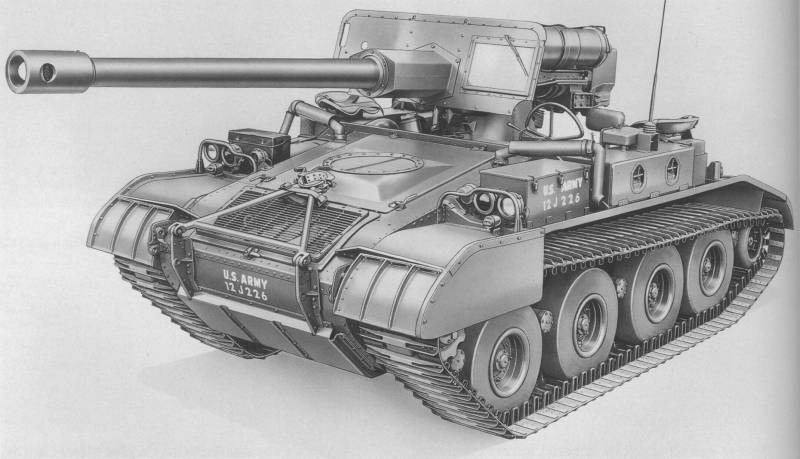
General view of the M56 serial ACS. Photo: Hunnicutt, RP "Sheridan. A History of the American Light Tank (Volume 2)"
In April of the following year, the ground forces command created new requirements for a promising anti-tank SAU. The military wanted a self-propelled tracked chassis armed with an 90-mm T119 tank gun. This tool was developed for use on new medium tanks and met the original task defined earlier. However, the use of the gun in its current form was not possible. For use in light self-propelled guns, it was necessary to change the gun assembly system, as well as to modify some of its other elements. New installation for the gun received the working designation T70, the gun itself - T125.
Soon the technical assignment was transferred to Cadillac Motor Car Division of General Motors, which was selected as the lead contractor. In the near future, the contractor was to develop a project and build two prototypes. In case of successful completion of the project, the company could expect to receive a new contract, implying the serial production of equipment.
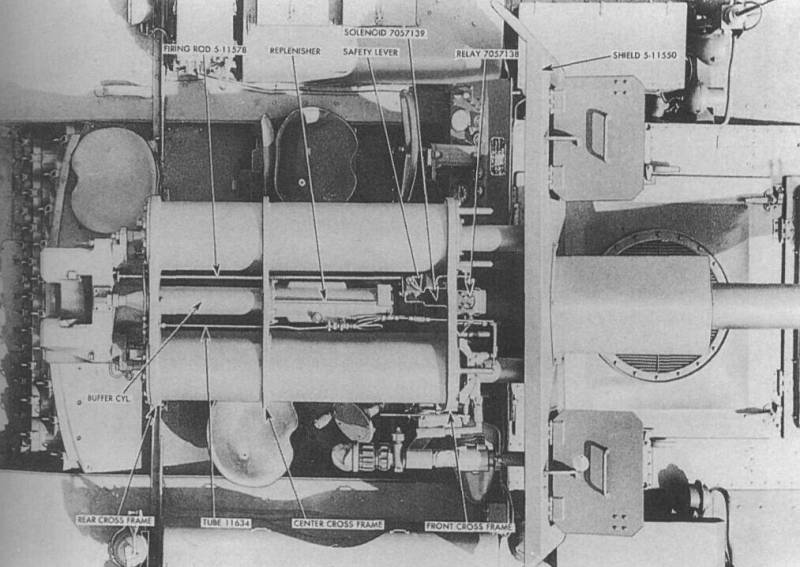
T101 prototype, top view. Photo: Hunnicutt, RP "Sheridan. A History of the American Light Tank (Volume 2)"
Initially, the project of promising self-propelled guns received the designation 90 mm Self-Propelled Gun T101. Subsequently, in the framework of the so-called. standardization, the combat vehicle and some of its individual elements were assigned new names. The ACS was called the M56 SPG, and the 90-mm gun was designated the M54. Known additional designation SPAT (Self-Propelled Anti-Tank - "Self-propelled anti-tank"). In addition, from a certain time self-propelled gun wore the unofficial nickname Scorpion ("Scorpion").
The prospective self-propelled guns were supposed to be transported by military transport aircraft, but the characteristics of such equipment of that time left much to be desired. As a result, when shaping the appearance of the equipment, some ideas that had become standard in the field of self-propelled artillery had to be abandoned, and new ambiguous solutions were applied. Perhaps the most prominent features of the T101 ACS concerned protection. To reduce the mass of the structure, it was decided to abandon the armored hull, and the crew protection should be provided only with a relatively large shield. In addition, the new model of technology differed unusual placement of some units.
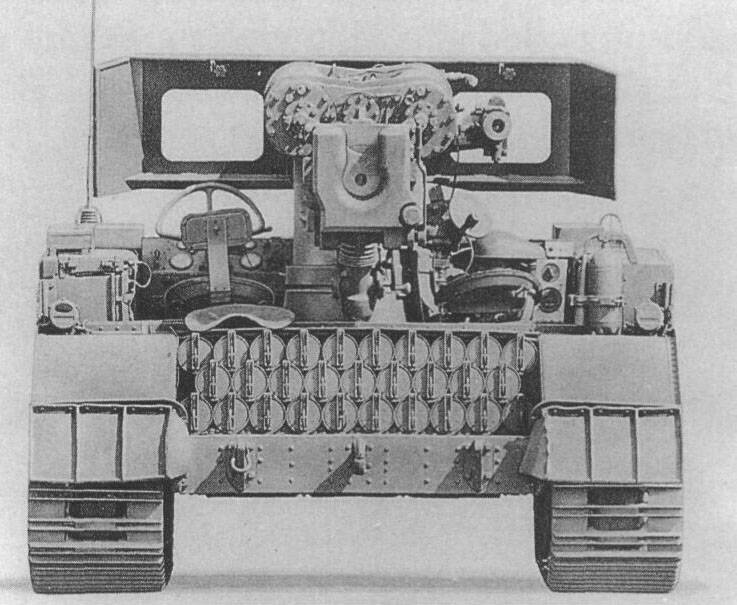
T101, view of the stern. Photo: Hunnicutt, RP "Sheridan. A History of the American Light Tank (Volume 2)"
Especially for the SAX T101, a new tracked chassis of the original design was developed. It had a traditional layout for American self-propelled guns with a front-mounted engine compartment and a fighting compartment occupying all other volumes. The body was proposed to be assembled on the basis of a frame, to which aluminum sheets of plating were joined with rivets. The frontal part of the body was actually a power unit housing. In its composition there were several inclined upper sheets; in the center there was a round hatch for access to the engine. There was a ventilation grille in front of the hatch. From the bottom, a curved sheet was connected to the upper part, to which another box-shaped device was attached. On the side of the hull frame, there were attached fences, used as the basis for the installation of lighting equipment.
Behind the engine compartment, the hull had a large volume to accommodate the crew compartment with weapons and crew. The central and aft parts of the hull were made in the form of a wide U-shaped tray, in which there were all the necessary units. An additional plate with a pair of supports was hinged on a narrow body aft sheet. When translating the machine into a combat position, this plate was folded back, increasing the aft platform, available for use by the crew. In the stowed position, it fit inside the case by turning forward.

The gun installation of the first prototype. Photo: Hunnicutt, RP "Sheridan. A History of the American Light Tank (Volume 2)"
A gasoline six-cylinder air-cooled Continental AOI-402-5 hp 200 hp engine was placed in front of the hull. In the form of a single power unit, the hydrodynamic transmission of the Allison CD-150-4 type was connected. It provided for the issuance of torque to the front drive wheels with switching between two forward gears and one reverse. The fuel tank with a capacity of 210 l was placed behind the engine compartment, on the floor of the crew compartment.
For T101 self-propelled guns, the original tracked undercarriage was developed. On each side of the hull there were four support rollers with an individual torsilastic suspension. The rollers were mounted on balancers like those used with torsions. In this case, the elastic suspension elements were located outside the body - in special cylindrical casings on balancers. The balancers of the three front pairs of rollers were turned forward, the stern pair - back. The rollers were made in the form of wheels with pneumatic tires. The latter were intended to absorb additional shocks when moving. The design of the wheels made it possible to continue driving even with punched tires for 10-15 minutes at speeds no more than 22-24 km / h.
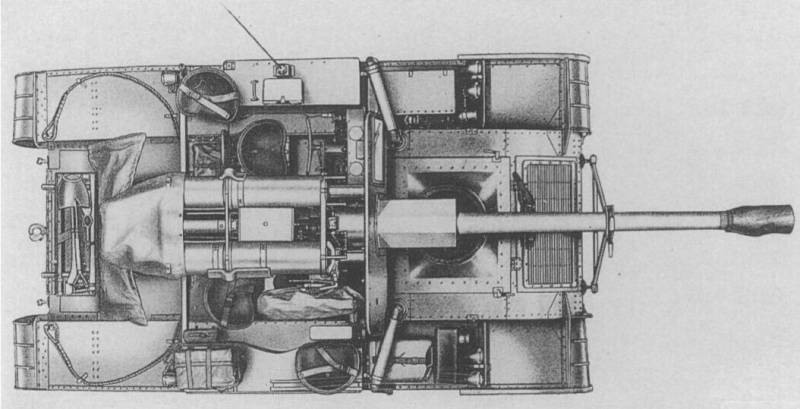
Top view of the production machine M56, visible changes in the fighting compartment. Photo: Hunnicutt, RP "Sheridan. A History of the American Light Tank (Volume 2)"
In front of the hull located drive wheels, in the stern - guides, differing in small diameter. Due to the presence of large track rollers, there was no need to use support rollers. Another way to facilitate the design of the combat vehicle has become an unusual caterpillar design. The caterpillar consisted of two looped ribbons made of rubberized fabric and reinforced with steel cables. In a single caterpillar with a width of 510 mm, two separate tapes were connected using a large number of transverse metal elements with cushions on the outer part. From the inside, such a caterpillar had two rows of crests, between which rollers and wheels moved.
In the central part of the chassis, a thumb-type T70 gun mount was mounted. Directly on the bottom of the case, a cylindrical support was installed with a rotating element on top. The latter had a semicircular notch and was intended for the installation of a rocking artillery unit. It was proposed to control the movement of an artillery installation using a set of hand-operated mechanisms. It was possible to deflect the gun on the 30 ° to the right or to the left from the axis of the machine. Elevation angles varied from -10 ° to + 15 °.
In front of the support of the swinging part, on the removed beam, the armor shield was fixed - the only protection of the crew against bullets or fragments. The shape and design of the shield changed several times. Thus, in the early version of the project it was proposed to use a rectangular shield of great width and small height with side elements curved back. In the center of the shield there was an embrasure for the gun, covered by a mask in the form of a hexagonal prism. On the sides of the embrasure, there were two glazed openings, equipped with armored covers. They were proposed to use for driving and pointing guns.
The main and only weapons The 90-mm T125 / M54 tank gun was to be a promising SAU. This gun had a barrel length 50 gauges and was equipped with a semi-automatic wedge moving in a vertical plane. The barrel was equipped with a single-chamber muzzle brake and sealed with hydraulic recoil devices. Two massive hydraulic cylinders were placed side by side above the barrel, occupying the space between the shield and the breech.
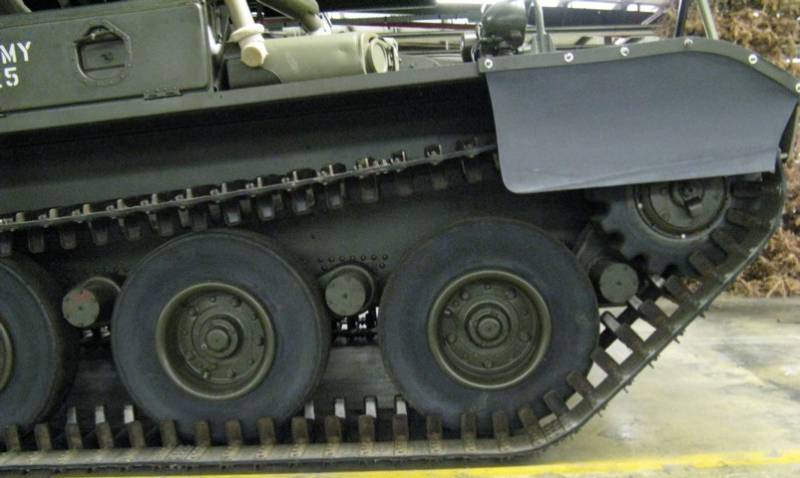
Chassis combat vehicle. Covers of elastic suspension elements are located between the support rollers. Photo Afvdb.50megs.com
The gun used unitary ammunition caliber 90 mm. Ammunition consisted of 29 shells. For their transportation, the car received the original design. At the bottom of the fighting compartment, just behind the cannon, there was a horizontal rack, equipped with three rows of pipe-cells. Outside, all the cells were additionally covered with a lightweight aluminum casing. Provision was made for the installation of a fabric awning, which provides additional protection for ammunition from external influences.
The ammunition M54 guns consisted of eight types of shells. They offered a cumulative, subcaliber, two high-explosive fragmentation, a practical one and a projectile with ready-made striking elements. There were also two types of cluster projectiles with different load options. The shots had a total weight from 14,6 kg (cumulative M431) to 19,9 kg (sub-caliber M318). The initial speed of ammunition, depending on their types, ranged from 730 to 1220 m / s. The maximum firing range exceeded 21 km, but in practice the destruction of targets could only be carried out at shorter distances. The relatively small mass of shots allowed, using manual reloading, to perform up to 10 shots per minute.
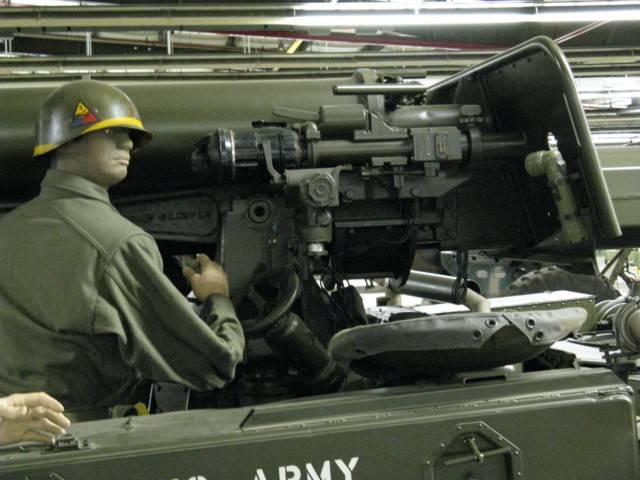
Workplace gunner. Photo Afvdb.50megs.com
The first version of the T101 project provided for the management of the car by a crew of three. In the fighting compartment, right behind the shield and to the left of the gun, there was a control post with a driver’s workplace. It was proposed to drive the car using a set of levers and a steering wheel in the form of the upper half of the steering wheel. You could follow the road through a glass window in the shield. To the right of the breech cannon placed the gunner's seat. At his workplace were sights and flywheels drives drives. Before the gunner in the shield there was a second windshield. Behind the driver was placed the third seat, which during the marches was supposed to be located loader. To the left of the loader, a radio station was placed on a fender. In a combat situation, the loader was on the stern of the hull.
Due to a number of original ideas and solutions that underlie the project, the T101 ACS turned out to be compact and light. The hull length was only 4,56 m, length with a cannon forward - 5,8 m. Width - 2,57 m, total height - 2 m with height of the line of fire 2,7 m. Combat weight did not exceed 7,15 t. Specific power about 28 hp per ton made it possible to get the maximum speed up to 45 km / h. Power reserve - 230 km. Due to the small size, the permeability was not too high. The width of the intersected trench was only 1,2 m, the height of the surmounted wall - 76, see. The self-propelled motor did not float, but could move along fords to a depth of 1,1 m.
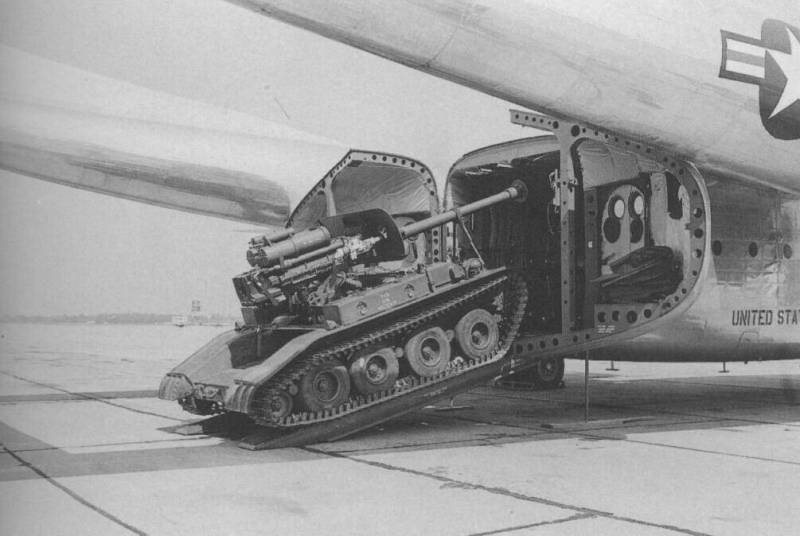
Loading M56 into C119 military transport aircraft. Photo: Hunnicutt, RP "Sheridan. A History of the American Light Tank (Volume 2)"
The dimensions and weight of the combat vehicle corresponded to the capabilities of existing and prospective military transport aircraft. It was also possible to transfer such equipment with the help of landing gliders with the corresponding capacity indicators. It was proposed to land the planes by landing method. Subsequently systems of parachute landing appeared.
Development of the project T101 took several years and lasted until the early fifties. After the design was completed, the production of the two required prototypes started. In 1951-52, this technique was tested at test sites, which allowed to determine the real characteristics and capabilities, as well as to make a list of the necessary improvements.
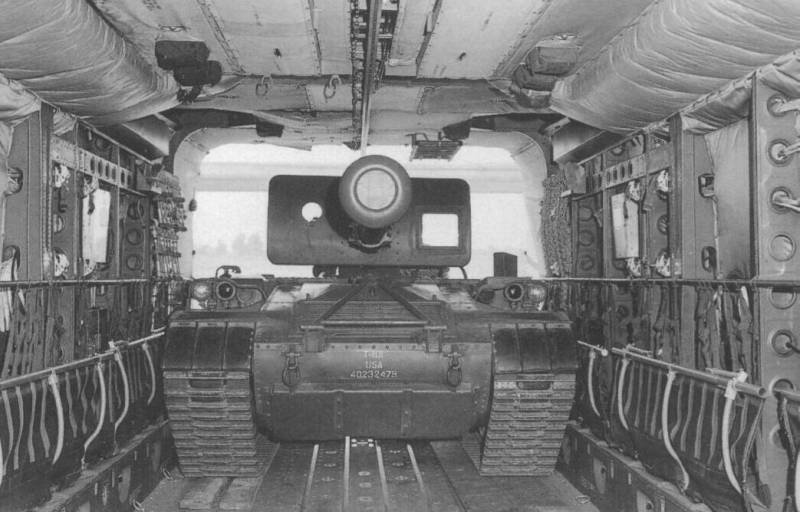
Self-propelled gun in the cargo cabin of the aircraft. Photo: Hunnicutt, RP "Sheridan. A History of the American Light Tank (Volume 2)"
In general, the presented prototypes staged the military, but to improve the performance and improve the combat capabilities required some changes. Thus, the protection of the crew in the form of a rectangular shield with two large windows was considered unacceptable even against the background of the absence of hull armor. It was decided to leave only the left windshield used by the driver. Instead of the right window in the armor, only a small round hatch needed to use the telescopic sight was to remain.
In battle, the crew of three people was subjected to excessive loads, which is why it was decided to increase it, adding a radio operator commander. The loader seat was removed from the left side of the fighting compartment. There, but on the fender, a new seat of the commander was installed. He had to be placed facing the gun and sideways in the direction of travel. On the march, the loader was asked to sit in front of the crew compartment, to the right of the gun and in front of the gunner. During the battle, he moved to the aft platform.
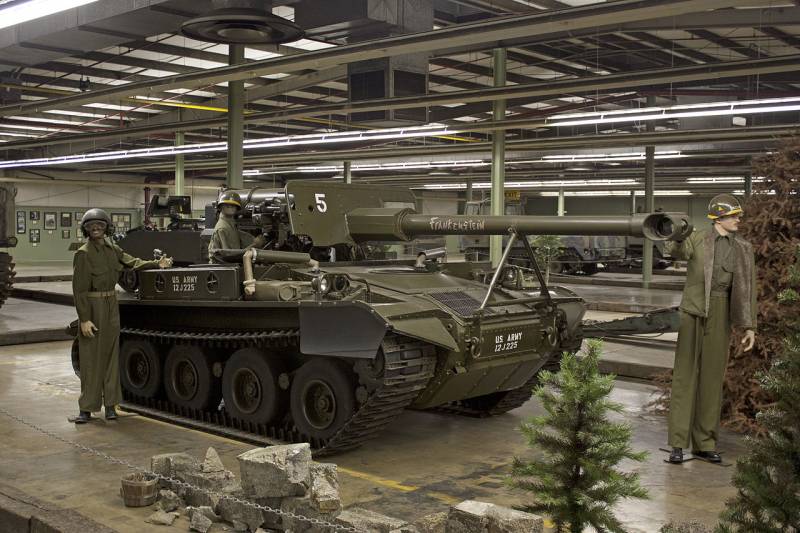
M56 self-propelled gun with the own name "Frankenstein" from the exposition of the Armored Foundation Museum. Perhaps the car got its name because of non-standard muzzle brake. Photo of Wikimedia Commons
According to the results of improvements made in view of the first tests and the wishes of the customer, the self-propelled gun was able to enter the troops. In 1953, the T101 anti-tank SAU was recommended for adoption and serial production. The equipment received the official designation M56, under which it was to serve in the army. The company Cadillac Motor Car Division of General Motors received an order for mass production of self-propelled guns. The release of such technology continued until the 1959 year. For six years, the manufacturer’s forces built and transferred the 325 military tracked combat vehicles.
During the first few years of operation, the latest M56 SPG / Scorpion self-propelled guns participated only in combat training activities. Later, in the sixties, this technique was first attracted to participate in hostilities. The United States entered the Vietnam War, during which amphibious units were to play the most important role. The small size and weight of the M56 made it possible to quickly transfer equipment to the required area, where troops needed fire support on the battlefield. A compatible nomenclature of ammunition allowed to solve a variety of combat missions.
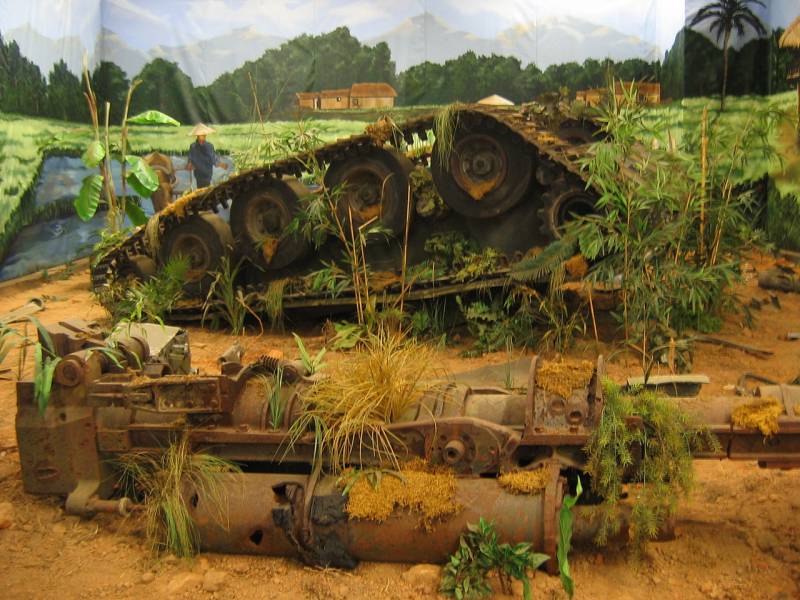
The remains of the ACS in the composition of the diorama dedicated to the Vietnam War. Museum Armored Foundation Museum. Photo of Wikimedia Commons
At the same time, the technique was not without flaws. As expected, the rejection of the reservation led to the corresponding consequences. Smash self-propelled guns could even enemy fighters with small arms, not to mention the more serious systems. In addition, the crew was not protected from shelling from the side or from behind. Thus, the M56 combat vehicle has proven to be a fairly effective means of fire support for the troops, however, requiring special approaches to the organization of combat work.
Operation of technology in Vietnam was quite active, but did not last too long. In the mid-sixties, the United States adopted the newest lightweight amphibious tank M551 Sheridan, which had a lot of advantages over the Scorpion. First of all, among the advantages of the tank should be noted the presence of a reservation and a more successful weapon system with a gun-launcher, as well as paired and anti-aircraft machine guns. By the end of the decade, the new equipment was sent to Southeast Asia, where gradually self-propelled guns were being forced out.
Mass production of Sheridan allowed to re-equip the amphibious units with the gradual decommissioning of the M56. Some of this technology was sent to the reserve, while other machines were planned to be sold to third countries. West Germany, Spain, South Korea and even Morocco soon became new operators of anti-tank self-propelled guns. Interestingly, only the Moroccan army happened to use American SAU in the course of a real conflict. Such a technique with a certain efficiency was used during the war in Western Sahara, which began in the 1975 year.
The operation of M56 SPAT / Scorpion self-propelled artillery mounts in third-country armies continued for a long time. Recent samples of such combat vehicles were written off only in the late eighties and early nineties. The bulk of write-off machines for the lack of prospects sent for recycling. Parts of equipment remaining in the United States are more fortunate. She did not cut and transferred to several museums. At the moment, almost fifty preserved M56 self-propelled guns are known. The vast majority of this technology is stored in the United States. A curious sample is in one of the German museums. At one time, decommissioned "Scorpion" was rebuilt into the original machine for training drivers. At least one self-propelled gun was rebuilt for use as a civilian tracked tractor.
The M56 Scorpion anti-tank SAU was created as a means to enhance airborne formations, as well as to protect them against enemy combat armored vehicles. The need to ensure the possibility of transportation by air led to a number of restrictions, which, in turn, had a specific impact on the design of self-propelled guns. However, with all its flaws, the resulting machine allowed to solve the tasks. At the same time, a specific design led to the fact that the appearance of newer models made the Scorpion no longer needed by the army. Thus, in fact, the M56 ACS has become a kind of temporary measure, necessary for the waiting period of more serious equipment. Soon, new improved designs were created, which made unarmored self-propelled guns unnecessary.
Based on:
http://afvdb.50megs.com/
http://militaryfactory.com/
http://the.shadock.free.fr/
http://massimocorner.com/
Hunnicutt, RP Sheridan. A history of the American Light Tank (Volume 2). Navato, CA: Presidio Press, 1995.
List of surviving ACS M56:
http://massimocorner.com/afv/Surviving_M56_Scorpions.pdf
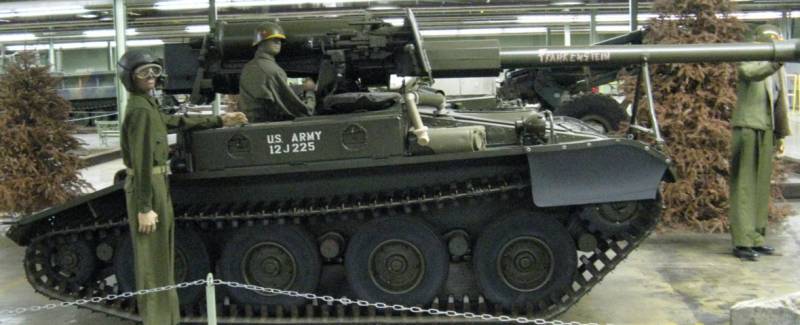
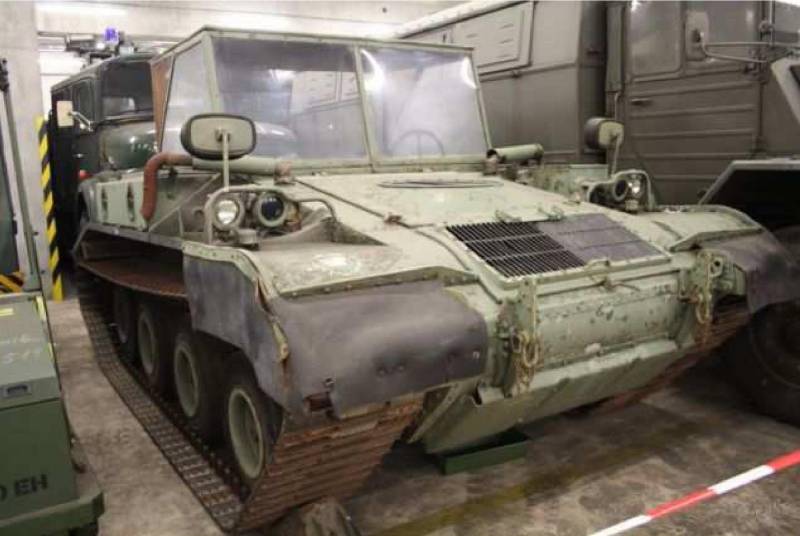
Information